Abstract
Maximizing the functional abilities of the individual is the primary objective of any therapeutic intervention. Functional outcome data are valuable to those involved in the care of the athlete because such data provides information that helps facilitate the clinical decision-making process and, therefore, helps insure a safe and efficient return to athletics. Functional outcome measures also provide useful data for assessing therapeutic intervention efficacy. The clinician/researcher must consider various factors when selecting an appropriate outcome measure, such as: the patient population, pathology, specific test parameters, psychometric properties, and practicality of the measure. The primary purpose of this paper is to provide the reader with guidelines for either assessing existing measures or developing new measures of functional outcomes for use in clinical practice and research.
Full text
PDF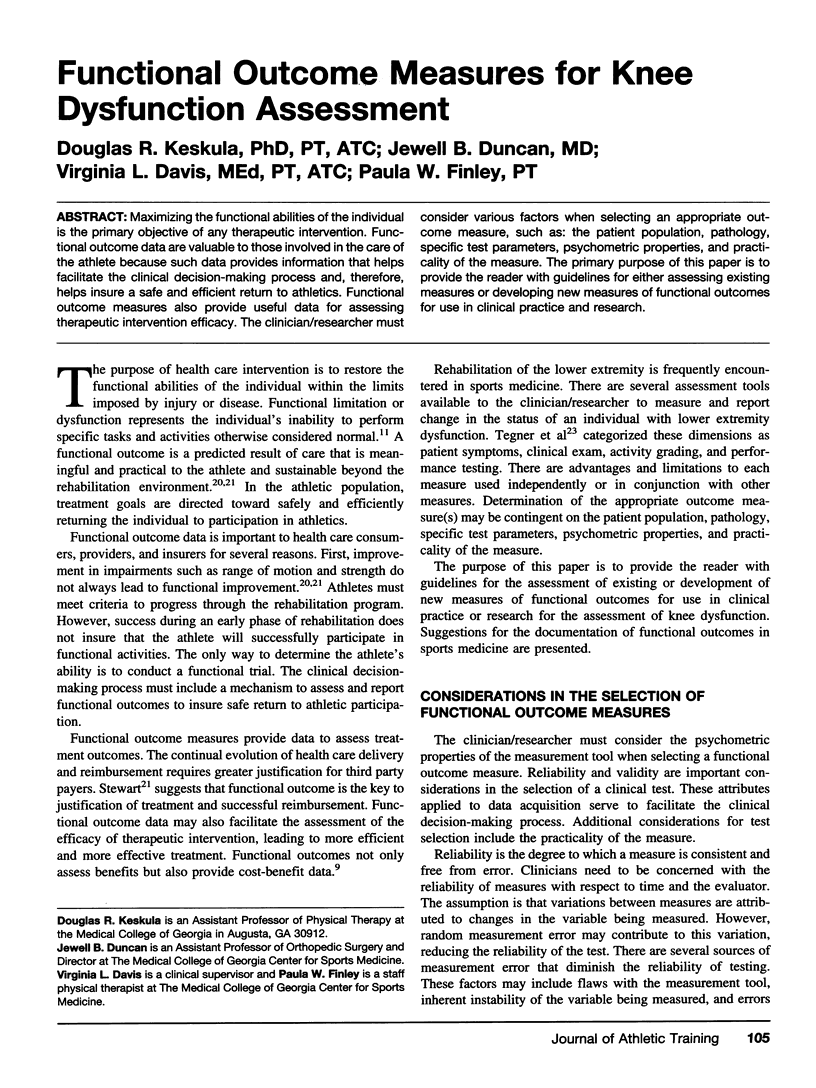
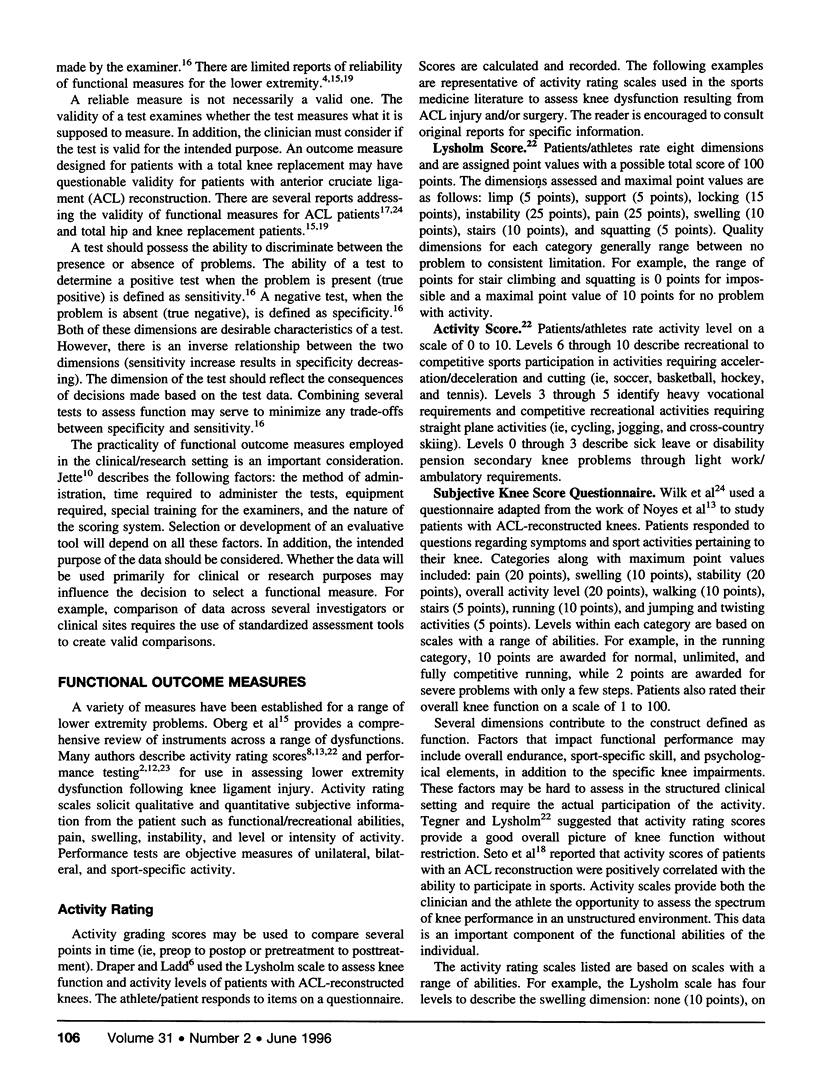
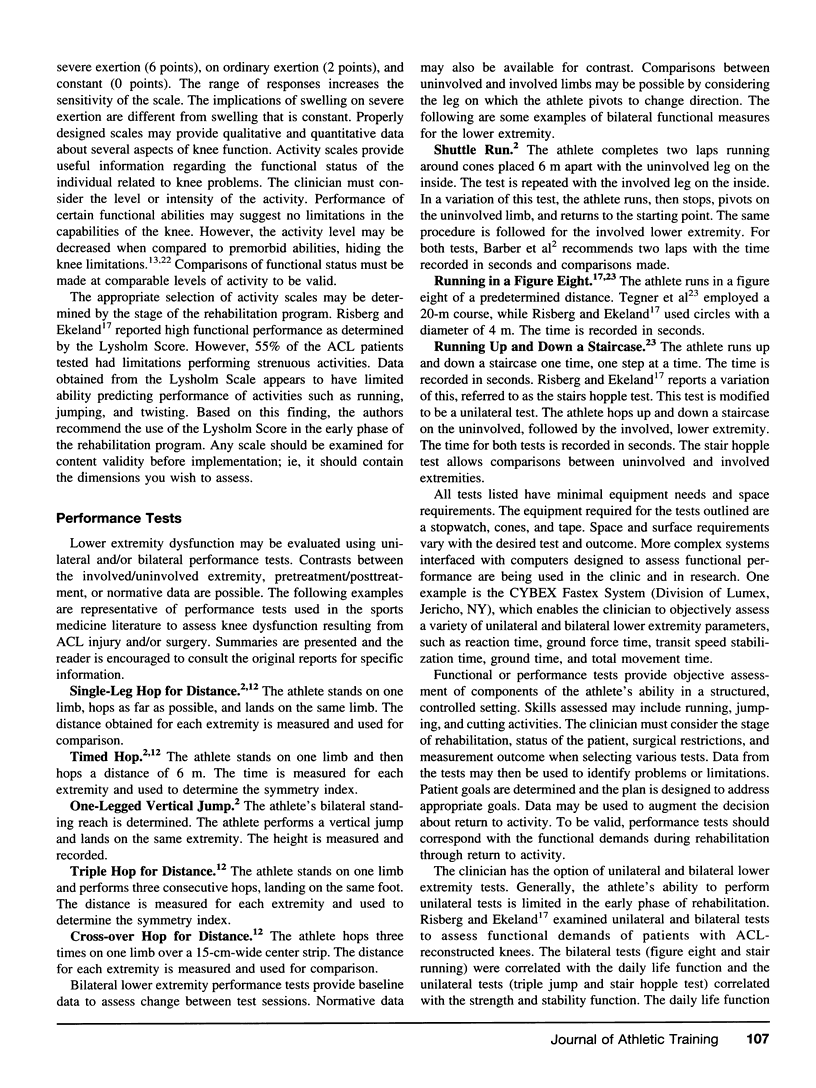
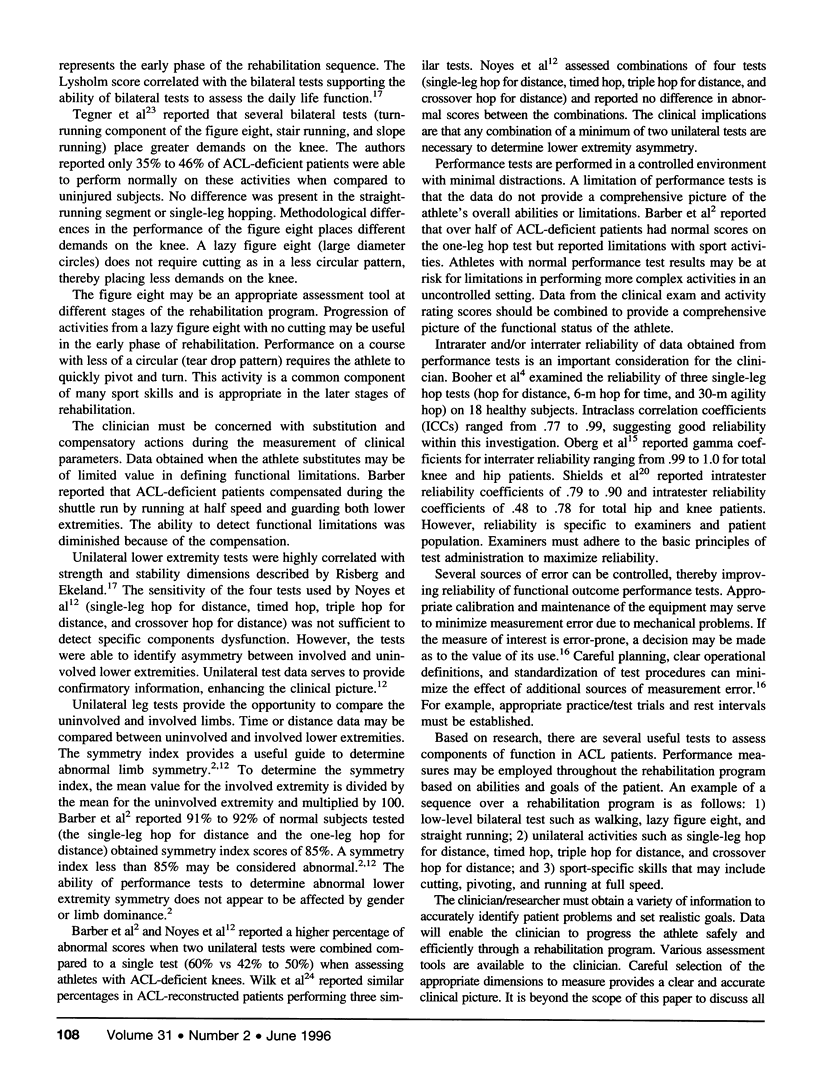
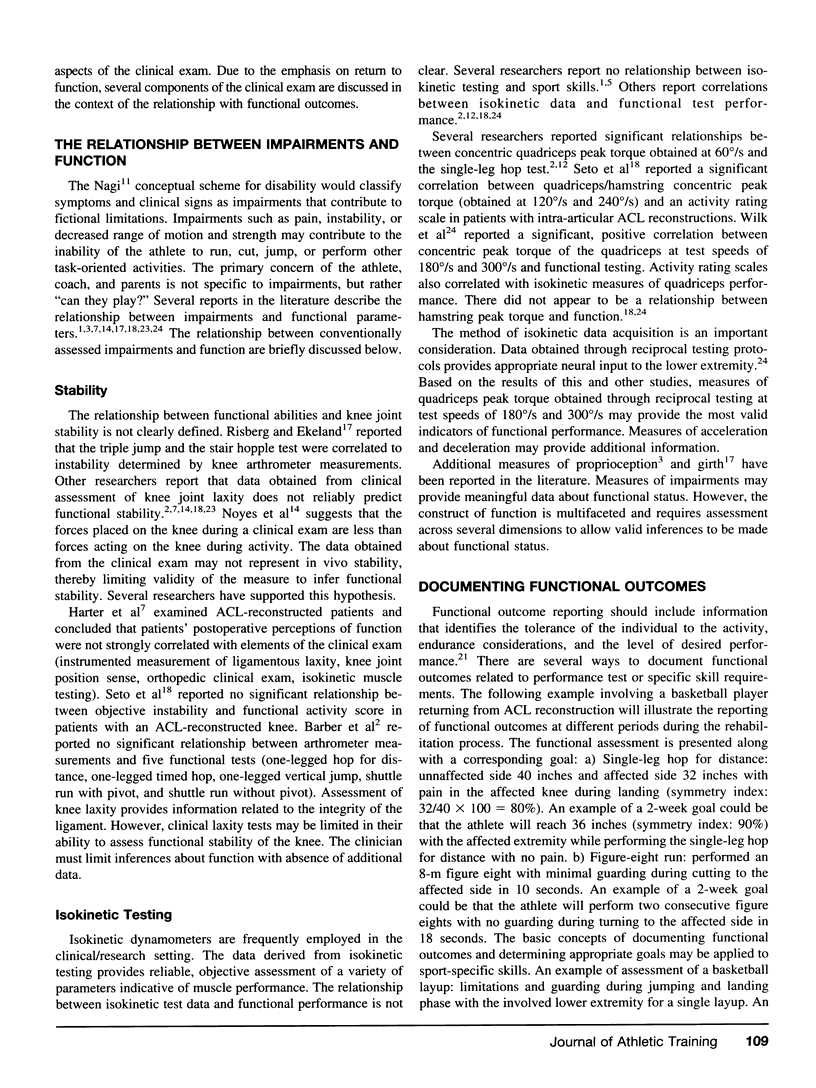
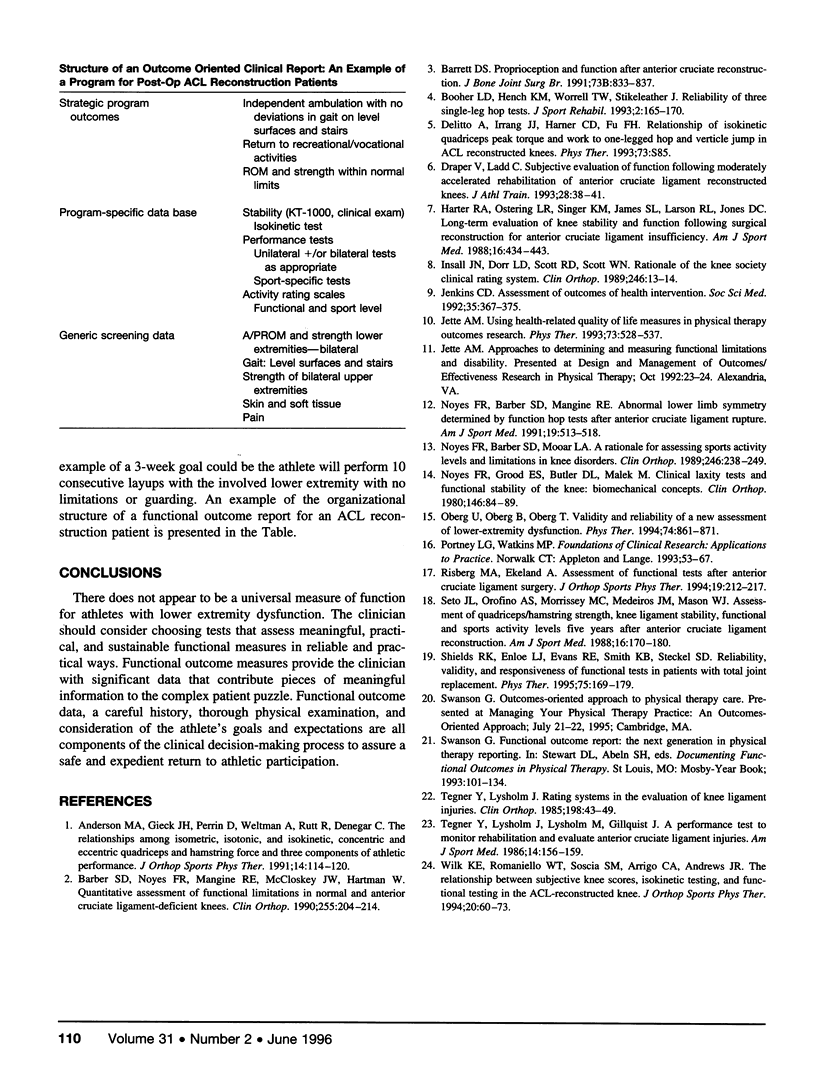
Selected References
These references are in PubMed. This may not be the complete list of references from this article.
- Barber S. D., Noyes F. R., Mangine R. E., McCloskey J. W., Hartman W. Quantitative assessment of functional limitations in normal and anterior cruciate ligament-deficient knees. Clin Orthop Relat Res. 1990 Jun;(255):204–214. [PubMed] [Google Scholar]
- Barrett D. S. Proprioception and function after anterior cruciate reconstruction. J Bone Joint Surg Br. 1991 Sep;73(5):833–837. doi: 10.1302/0301-620X.73B5.1894677. [DOI] [PubMed] [Google Scholar]
- Draper V., Ladd C. Subjective evaluation of function following moderately accelerated rehabilitation of anterior cruciate ligament reconstructed knees. J Athl Train. 1993 Spring;28(1):38–41. [PMC free article] [PubMed] [Google Scholar]
- Harter R. A., Osternig L. R., Singer K. M., James S. L., Larson R. L., Jones D. C. Long-term evaluation of knee stability and function following surgical reconstruction for anterior cruciate ligament insufficiency. Am J Sports Med. 1988 Sep-Oct;16(5):434–443. doi: 10.1177/036354658801600502. [DOI] [PubMed] [Google Scholar]
- Insall J. N., Dorr L. D., Scott R. D., Scott W. N. Rationale of the Knee Society clinical rating system. Clin Orthop Relat Res. 1989 Nov;(248):13–14. [PubMed] [Google Scholar]
- Jenkins C. D. Assessment of outcomes of health intervention. Soc Sci Med. 1992 Aug;35(4):367–375. doi: 10.1016/0277-9536(92)90329-o. [DOI] [PubMed] [Google Scholar]
- Jette A. M. Using health-related quality of life measures in physical therapy outcomes research. Phys Ther. 1993 Aug;73(8):528–537. doi: 10.1093/ptj/73.8.528. [DOI] [PubMed] [Google Scholar]
- Noyes F. R., Barber S. D., Mangine R. E. Abnormal lower limb symmetry determined by function hop tests after anterior cruciate ligament rupture. Am J Sports Med. 1991 Sep-Oct;19(5):513–518. doi: 10.1177/036354659101900518. [DOI] [PubMed] [Google Scholar]
- Noyes F. R., Barber S. D., Mooar L. A. A rationale for assessing sports activity levels and limitations in knee disorders. Clin Orthop Relat Res. 1989 Sep;(246):238–249. [PubMed] [Google Scholar]
- Noyes F. R., Grood E. S., Butler D. L., Malek M. Clinical laxity tests and functional stability of the knee: biomechanical concepts. Clin Orthop Relat Res. 1980 Jan-Feb;(146):84–89. [PubMed] [Google Scholar]
- Oberg U., Oberg B., Oberg T. Validity and reliability of a new assessment of lower-extremity dysfunction. Phys Ther. 1994 Sep;74(9):861–871. doi: 10.1093/ptj/74.9.861. [DOI] [PubMed] [Google Scholar]
- Risberg M. A., Ekeland A. Assessment of functional tests after anterior cruciate ligament surgery. J Orthop Sports Phys Ther. 1994 Apr;19(4):212–217. doi: 10.2519/jospt.1994.19.4.212. [DOI] [PubMed] [Google Scholar]
- Seto J. L., Orofino A. S., Morrissey M. C., Medeiros J. M., Mason W. J. Assessment of quadriceps/hamstring strength, knee ligament stability, functional and sports activity levels five years after anterior cruciate ligament reconstruction. Am J Sports Med. 1988 Mar-Apr;16(2):170–180. doi: 10.1177/036354658801600215. [DOI] [PubMed] [Google Scholar]
- Shields R. K., Enloe L. J., Evans R. E., Smith K. B., Steckel S. D. Reliability, validity, and responsiveness of functional tests in patients with total joint replacement. Phys Ther. 1995 Mar;75(3):169–179. doi: 10.1093/ptj/75.3.169. [DOI] [PubMed] [Google Scholar]
- Tegner Y., Lysholm J., Lysholm M., Gillquist J. A performance test to monitor rehabilitation and evaluate anterior cruciate ligament injuries. Am J Sports Med. 1986 Mar-Apr;14(2):156–159. doi: 10.1177/036354658601400212. [DOI] [PubMed] [Google Scholar]
- Tegner Y., Lysholm J. Rating systems in the evaluation of knee ligament injuries. Clin Orthop Relat Res. 1985 Sep;(198):43–49. [PubMed] [Google Scholar]
- Wilk K. E., Romaniello W. T., Soscia S. M., Arrigo C. A., Andrews J. R. The relationship between subjective knee scores, isokinetic testing, and functional testing in the ACL-reconstructed knee. J Orthop Sports Phys Ther. 1994 Aug;20(2):60–73. doi: 10.2519/jospt.1994.20.2.60. [DOI] [PubMed] [Google Scholar]


